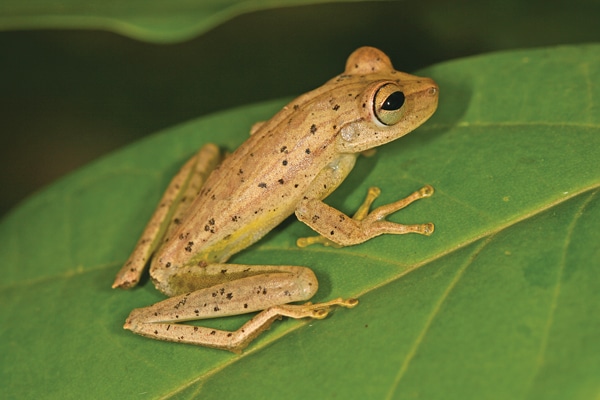Nestled in Bolivia’s northwestern region, Madidi National Park boasts a staggering diversity of flora and fauna, occurring in nearly 2 million h
Nestled in Bolivia’s northwestern region, Madidi National Park boasts a staggering diversity of flora and fauna, occurring in nearly 2 million hectares of primary forests. It is touted by renowned organizations, such as Conservation International, Wildlife Conservation Society and National Geographic, as the most bio-diverse place on the planet. A quick Internet search reveals that Madidi is highly regarded as the place to explore pristine jungle habitat.
Getting to Madidi, however, is not exactly easy. After landing in Bolivia’s capitol of La Paz, which at nearly 13,000 feet above sea level can literally take your breath away, one must hop on a small prop plane and fly into the remote town of Rurrenabaque. From here the only access to the national park is by a five-hour boat ride along the Tuichi and Beni Rivers. The boat ride was quite pleasant, and en route, numerous colorful birds were seen, including various parrots, macaws, herons and even one of the largest birds in the Western Hemisphere: king vultures. Careful observation also revealed basking river turtles (Podocnemis spp.) near the shoreline, as well as scores of colorful tropidurid lizards (Tropidurus melanopleurus) scampering around on cliff walls.
Read More
Looking For Reptiles In The Amazon
Herping Brazil's Refugio Ecologico Caiman
4 Ways to Create A Backyard Herp Haven
The mile-long walk from the boat landing to our home in the jungle, the Chalalan Ecolodge, was a great opportunity to finally see some of the herpetofauna of the region. Walking along the well-marked path, several lizards scurried up tree trunks and dove for cover under the leaf litter at our approach. Whorltail lizards (Stenocercus prionotus) were the most commonly encountered species, as well the anole lizard (Anolis fuscoauratus). Skinks are uncommon here, but we did come across one Copeoglossum nigropunctatum. Before reaching the lodge, an adult Esmarald racer (Drymobius rhombifer) was found basking in the middle of the trail. Our entire group of four hikers, however, walked right over it nearly stepping on it before our guide finally pointed it out.

paul freed
Amazon tree boa (Corralus hortulanus).
One of the more notable residents here in the park isn’t a herp but actually a colorful species of primate. In 2005, a new species of titi monkey was discovered living in this vast jungle, and researchers decided that its common name would be awarded to whoever would provide the largest financial contribution to the group of scientists who originally discovered it. Interestingly, a Canadian online casino won the right to name the animal, which is now known as the golden palace monkey (Callicebus aureipalatii). It was a special treat to encounter this new member of the primate family even before reaching our final destination.
The accommodations at Chalalan were somewhat modest. Our travel companions, Jonathan Perez and Mike Davis, shared a room, which consisted solely of two beds, each covered by mosquito netting. The bathroom was a communal one and was shared by other visitors in their dorm-style cabin. My wife, Barbara, and I had booked the matrimonial suite well in advance, which had two spacious rooms and a private bathroom, complete with a pair of bony-headed tree frogs (Osteocephalus taurinus) that had taken up residence in our toilet. Also sharing our room, above our bed, was an incredibly ornate-looking jumping spider (of the Salticidae family). With a bright-red head and abdomen, this fingernail-sized arachnid was by far the most attractive spider I had ever seen.
While settling into our rooms a raucous disturbance took place in the trees overhead. A large troop of more than 100 squirrel monkeys and dozens of white-fronted capuchin monkeys raced through our campsite, shattering the silence. It was quite a sight.
On the Water
In the center of the vast compound lies Chalalan Lake, spanning nearly a mile in length it is surrounded by lush forest. Small rowboats were available to guests, allowing leisurely trips on the waterway, mostly as a venue for bird watching. Before sunset, we commandeered one of the vessels and slowly circumnavigated the lake in search of wildlife. As we drifted into a bush by the north end of the lake, we observed several squirrel monkeys feeding on berries that were overhanging the water. A few feet below them, we caught a glimpse of an elongate, slender green shape gliding slowly through the foliage. Lunging forward, I managed to grab the 4-foot-long green vine snake (Oxybelis fulgidus) before it escaped into the thick underbrush. It was a handsome specimen, lime green with an absurdly pointed snout. I was glad it made no attempt to defend itself, as this rear-fanged snake will oftentimes bite savagely, which can result in a nasty, painful wound.
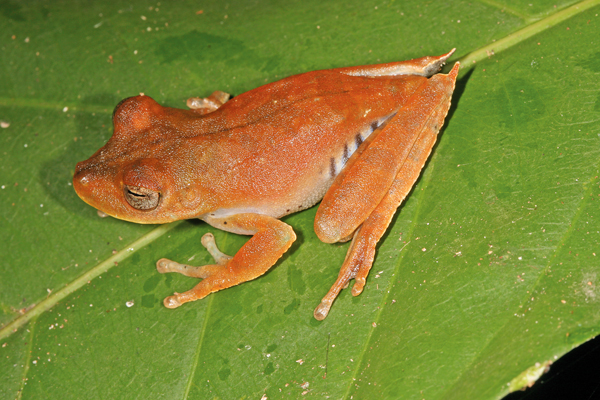
paul freed
Hypsiboas calcaratus.
Along the shore, adjacent to the boat dock, nested a sizable colony of one of the world’s strangest and most primitive birds—the hoatzin (Opisthocomus hoazin). Adults have long, orange spiky feather shafts, rising straight up from their heads. Their eyes are a vivid crimson red surrounded by sky-blue “eye shadow.” Juveniles have a specialized claw at the end of their naked wings, and if threatened or attacked, will fall from their nest into the water below. When the danger has passed, they will use their sharp claws as grappling hooks to ascend back up into their home. It was a thrill to be able to approach these odd-looking birds and capture their unique beauty on film.
As the sun began to set, we heard several different frog species calling by the shores’ edge. We paddled our boat toward their calls and saw spotted tree frogs (Hypsiboas punctatus) and narrow-headed tree frogs (Scinax cruentomma) amidst the vegetation. Shining our flashlights higher in the trees revealed a pale-colored Amazon tree boa (Corallus hortulanus) on the move. Tree boas have extremely reflective eye-shine and can be easily spotted, even from great heights in the forest canopy.
Equally reflective is the eye-shine from crocodilians, and as our flashlight beams skimmed the surface of the water, an orange glow became visible from across the lake. Steering our boat toward the glowing spheres, we came upon a half-submerged black caiman (Melanosuchus niger). This member of the alligator family is perhaps the largest reptile in the New World, and specimens of nearly 20 feet in length have been reported. Our specimen was a mere youngster at just over 6 feet long. The staff at Chalalan talks about seeing really large individuals, some occasionally exceeding 10 feet from tip to tip.
On the Trail
Back on land, we began walking the extensive system of trails that crisscross throughout the park. More than 20 miles of trails were created just around the lodge to ensure that visitors have ample access to all the natural wonders that Madidi has to offer. We hadn’t walked more than two minutes when we encountered another Amazon tree boa hanging from a bush less than 3 feet off the ground. This species normally prefers a much higher perch, and we were rather surprised to see it so close to the ground.
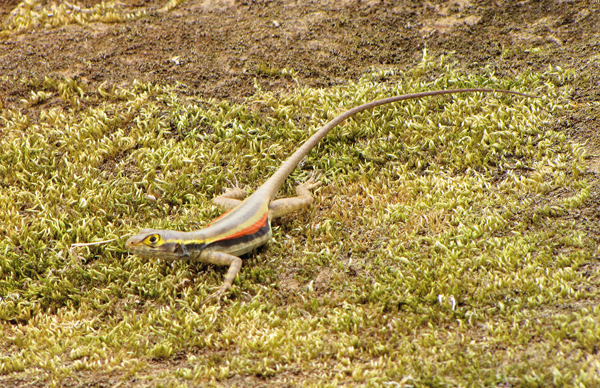
paul freed
Tropidurus lizard (Tropidurus melanopleurus).
The nighttime sounds of calling insects and frogs were at times deafening. A recent rain was undoubtedly the reason for so much anuran activity, and we were delighted to encounter so many species in a single night. Large marine toads (Rhinella marina) and equally sized smokey jungle frogs (Leptodactylus pentadactylus) fled the pathways at our approach. Smaller toads, such as the South American common toad (Rhinella margaritifera, formerly Bufo typhonius), granular toads (Rhinella major, formerly Bufo granulosus), the Strabomantid frog (Pristimantis reichlei), and the narrow-mouth Amazon sheepfrog (Hamptophryne boliviana) revealed themselves as they hopped away from our bright lights. Of special significance was encountering an endemic species named for the national park, Oreobates madidi.
Walking slowly and quietly through the nighttime jungle I aimed my light high in hopes of finding additional tree boas. Although no boas were seen, my patience was eventually rewarded with a colubrid snake coiled some 15 feet off the ground amidst the thin branches at the end of a tree. It was well out of reach, and before attempting to capture it, I took a few photographs in case it was able to escape. While everyone else trained their lights on the snake, I carefully began to climb up the tree. No sooner than I began my accent, the snake woke up and shot into the darkness. The digital image I took appears to be that of a 6-foot-long “sipo,” most likely Chironius exoletus.
A small ephemeral pond near one of the trails proved very rewarding, and while walking around its edge, several frogs dove into the water. We waited patiently, and when they finally rose to the surface to breathe, we were able to photograph them. One was a Gunther’s banded tree frog (Hypsiboas fasciatus), another was a closely related frog, the convict tree frog (H. calcaratus), so called because of the black stripes present on the inner thighs and abdomen. While meticulously searching the pond for additional signs of life, our flashlights revealed two more welcome finds. A hatchling black caiman less than a foot long was floating in the center of the pond, seemingly oblivious to our presence. After bombarding the young reptile with numerous camera flashes, it finally submerged and disappeared on the soft, muddy bottom. Resting inches from the caiman, was a Suriname toad (Pipa pipa), which for us was another exciting discovery.
The Main Trail
The following morning, we were anxious to check out the main trail that originally brought us to the lodge. We knew it would lead us back to the river, and we hoped to find a greater diversity of herps along the way. With the warming rays of the morning sun, we came across several giant ameivas (Ameiva ameiva) basking in small clearings. These were lightning-fast and extremely wary of our approach. As we got deeper into the forest, we could hear the faint buzzing sounds of what appeared to be insects. Barbara, however, was not convinced that they were coming from invertebrates and broke away to find its source. She was right. Although she did not capture the animal by hand, she did capture it on film. A male poison frog (Ameerega hahneli) was belting out its mating call, hoping to attract a female into its territory. This otherwise drab-colored frog had bright-orange flash markings in its thighs and armpits and a pale blue underside. Not the most colorful of the poison frog family, but a handsome animal nonetheless.
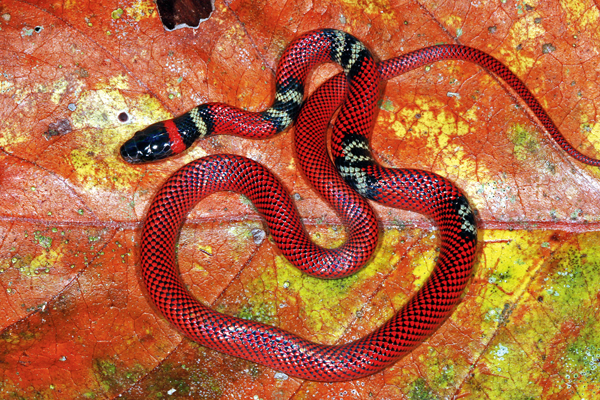
paul freed
Oxyrhopus melanogenys.
At the river, we split up to cover more ground, Barbara and I went one way and Jonathan and Mike went the opposite way. At the shoreline, we saw a few men fishing, and as we got closer one of them began pulling in what appeared to be a substantial-sized fish. To our surprise, and I imagine theirs as well, he landed a rather large Geoffrey’s side-necked turtle (Phrynops geoffroanus)! The men laughed at our reaction and were quite amused when we asked if we could photograph their haul. Fearful that they would want to keep the turtle for the dinner pot, I meekly asked if I could turn the animal loose back into the river. The man hesitated briefly and then nodded his approval. Close to where the men were fishing, I kicked over a piece of bark and a rugose gray toad (Rhinella poeppigii) scurried out from beneath looking for new cover. As I pounced on the toad the men once again reacted in amusement to my antics.
Meanwhile, Mike had the great fortune to find a yellow-foot tortoise (Chelonoidis denticulata). “It was like finding a needle in a haystack,” he said after a guide tried to describe the area where they are sometimes found. All in all the outing proved very successful.
Not too Crappy
As darkness began to fall we made our way back to camp where one of the guides, a self-proclaimed amateur herpetologist, promised to take us to a special haunt: Lake Caca. “You mean Lake Titicaca,” I asked, “that’s quite a distance from here.” He was actually referring to the septic system on the outskirts of the lodge, which they jokingly dubbed Lake Caca.
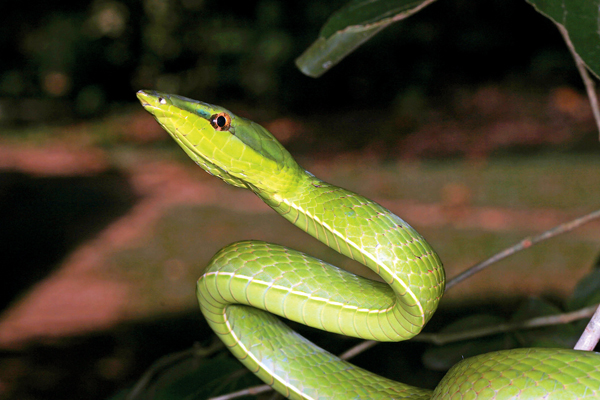
paul freed
Oxybelis fulgidus.
He promised an interesting assortment of frogs and snakes, and we weren’t about to question his knowledge of the area. About three quarters of a mile from our camp was a large cement pool encircled by a chain-link fence. Even from a distance we could see numerous frog silhouettes perched throughout the enclosure. The majority were black-eyed monkey tree frogs (Phyllomedusa camba), a few were the giant monkey tree frogs (P. bicolor), one was a white-lined leaf frog (P. vaillantii) and there were several bony-headed tree frogs, as well. It was amazing to see so many related hylids concentrated in one place. Of course, under the circumstance, it was quite obvious why the insect population was in such abundance here, which consequently attracted large numbers of frogs.
With so many frogs it was not surprising that the area was also home to a healthy population of snakes. Most commonly encountered was the arboreal brown sipo (Chironius fuscus). Also found in the region are slug-eating snakes (Dipsas spp.), cat-eyed snakes (Leptodeira spp.) and blunt-headed tree snakes (Imantodes spp.). Interestingly, despite our guides’ insistence that numerous species of vipers (Bothrops) and even bushmasters (Lachesis muta) are often seen in Madidi, we did not encounter a single venomous snake during our week-long stay.
Late into the night we decided to call it quits, and as we headed back to the lodge, one last scan of my flashlight revealed yet another treasure: an Amazon emerald tree boa (Corallus batesi) coiled 8 feet above us. It was a magnificent, 4-foot-long specimen that must have recently fed, as it had a very distinct bulge at mid body. Once again, our incessant camera flashes drove the snake to retreat high into the canopy, but the excitement of the find lasted well beyond the night.
The following morning, as we bid farewell to the staff, I was given a gift by my herping buddies—a small cloth sack tied carefully at the top. I cautiously opened the bag and poured its contents out on the ground in front of our group. There lay an exquisitely colored juvenile false coral snake (Oxyrhopus melanogenys). The 15-inch-long colubrid was a brilliant-red color with four triad-colored bands ending a third the length of its body. Our guide had apparently found the snake the previous night while in cahoots with Jonathan and Mike, and they wanted to surprise me with the photo opportunity just prior to our departure. It was a most fitting gift for such an amazing place.
Paul Freed was supervisor of herpetology for the Houston Zoo for 25 years. Fieldwork for the Carnegie Museum of Natural History and Conservation International has taken him to Paraguay, Namibia and other countries. He has authored many works, including the book Of Golden Toads and Serpents’ Roads.

